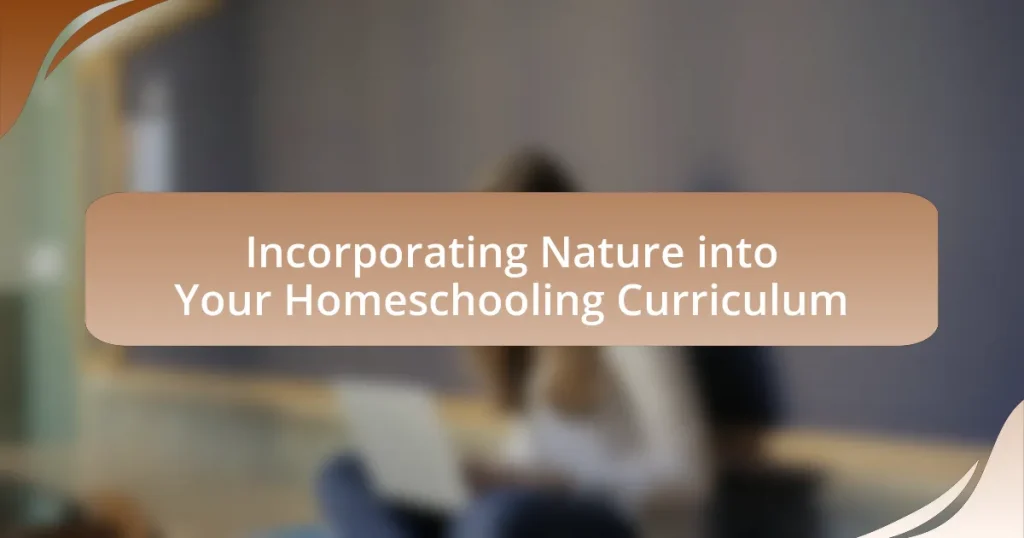Incorporating nature into your homeschooling curriculum involves integrating outdoor experiences and natural elements into educational activities, enhancing learning through hands-on exploration and observation. This approach has been shown to improve cognitive function, creativity, and emotional well-being in children. The article discusses the benefits of nature-based learning, including enhanced educational outcomes, cognitive development, and emotional growth, while providing effective strategies for integrating nature into lessons. It also addresses potential challenges and misconceptions, offering practical tips for successfully implementing nature-focused education in a homeschooling environment.

What does it mean to incorporate nature into your homeschooling curriculum?
Incorporating nature into your homeschooling curriculum means integrating outdoor experiences and natural elements into educational activities. This approach enhances learning by providing hands-on experiences that promote observation, exploration, and a deeper understanding of ecological systems. Research indicates that children who engage with nature exhibit improved cognitive function, creativity, and emotional well-being, as highlighted in studies by the Children & Nature Network. By utilizing local parks, gardens, and natural habitats, homeschooling parents can create a dynamic learning environment that fosters curiosity and a connection to the environment.
How can nature-based learning enhance educational outcomes?
Nature-based learning enhances educational outcomes by fostering engagement, improving retention, and promoting holistic development. Research indicates that students who participate in outdoor learning experiences demonstrate higher levels of motivation and interest in their studies. For instance, a study published in the Journal of Environmental Education Research found that students engaged in nature-based curricula scored 27% higher on standardized tests compared to their peers in traditional settings. Additionally, nature-based learning supports social-emotional skills, as children develop teamwork and communication abilities through collaborative outdoor activities. This multifaceted approach not only enriches academic performance but also nurtures critical thinking and problem-solving skills, essential for lifelong learning.
What are the cognitive benefits of learning in nature?
Learning in nature enhances cognitive development by improving attention, memory, and problem-solving skills. Research indicates that exposure to natural environments can lead to increased focus and reduced mental fatigue, as evidenced by a study published in the journal “Environmental Science & Technology,” which found that individuals who spent time in nature showed a 20% improvement in attention span compared to those in urban settings. Additionally, learning in natural settings fosters creativity and critical thinking, as children engage in hands-on exploration and inquiry-based learning. This connection to nature not only supports cognitive growth but also promotes emotional well-being, further reinforcing the benefits of integrating nature into educational practices.
How does nature-based education support emotional development?
Nature-based education supports emotional development by fostering resilience, empathy, and self-regulation in children. Engaging with natural environments allows children to experience challenges and learn coping strategies, which enhances their emotional resilience. Studies show that outdoor activities promote social interactions, leading to increased empathy as children collaborate and communicate with peers. Additionally, exposure to nature has been linked to reduced stress and anxiety levels, contributing to better emotional regulation. Research conducted by the University of Illinois found that children who participate in nature-based programs exhibit improved mood and emotional well-being, reinforcing the positive impact of nature on emotional development.
Why is it important to include nature in homeschooling?
Including nature in homeschooling is important because it enhances children’s learning experiences and promotes their overall well-being. Engaging with the natural environment fosters curiosity, critical thinking, and observational skills, which are essential for cognitive development. Research indicates that children who spend time in nature exhibit improved attention spans and reduced stress levels, contributing to better academic performance. For instance, a study published in the Journal of Environmental Psychology found that outdoor learning environments significantly boost students’ engagement and retention of information. Thus, incorporating nature into homeschooling not only enriches educational content but also supports emotional and physical health.
What role does nature play in fostering curiosity and exploration?
Nature plays a crucial role in fostering curiosity and exploration by providing diverse stimuli that engage the senses and provoke questions. The dynamic environments found in nature, such as forests, rivers, and mountains, encourage individuals, especially children, to observe, investigate, and interact with their surroundings. Research indicates that outdoor experiences enhance cognitive development and promote problem-solving skills, as children learn to navigate and make sense of complex natural systems. For instance, a study published in the journal “Frontiers in Psychology” by authors Frances Kuo and Andrea Faber Taylor highlights that exposure to natural settings significantly boosts attention and creativity, which are essential components of curiosity and exploration.
How can nature help in developing critical thinking skills?
Nature enhances critical thinking skills by providing real-world contexts for problem-solving and observation. Engaging with natural environments encourages learners to ask questions, analyze their surroundings, and draw conclusions based on evidence. For instance, studies show that outdoor learning experiences improve students’ ability to think critically and creatively, as they encounter complex ecosystems that require them to evaluate variables and make decisions. Research conducted by the University of Illinois found that students who participated in nature-based education demonstrated higher levels of critical thinking and problem-solving skills compared to those who learned in traditional classroom settings. This evidence supports the notion that nature serves as a dynamic classroom, fostering essential cognitive skills.

What are effective strategies for incorporating nature into your curriculum?
Effective strategies for incorporating nature into your curriculum include outdoor learning experiences, nature-based projects, and integrating environmental themes across subjects. Outdoor learning experiences, such as field trips to parks or nature reserves, allow students to engage directly with their environment, fostering observation and inquiry skills. Nature-based projects, like creating a garden or conducting experiments related to local ecosystems, provide hands-on learning opportunities that enhance understanding of biological and ecological concepts. Additionally, integrating environmental themes into subjects like science, art, and literature can deepen students’ appreciation for nature and its importance, as evidenced by studies showing that nature-based education improves student engagement and academic performance.
How can you design nature-based lessons?
To design nature-based lessons, educators should integrate outdoor experiences with curriculum objectives. This can be achieved by planning activities such as nature walks, where students observe and document local flora and fauna, thereby enhancing their observational skills and understanding of ecosystems. Research indicates that outdoor learning can improve student engagement and retention of information, as demonstrated in a study by the University of Illinois, which found that students who participated in outdoor education scored higher on standardized tests compared to their peers in traditional classroom settings. By aligning these activities with educational standards, educators can create meaningful and effective nature-based lessons.
What types of activities can be included in a nature curriculum?
A nature curriculum can include activities such as nature walks, gardening, wildlife observation, and outdoor science experiments. Nature walks allow students to explore local ecosystems, while gardening teaches them about plant biology and sustainability. Wildlife observation fosters an understanding of animal behavior and habitats, and outdoor science experiments provide hands-on learning opportunities related to environmental science. These activities are supported by educational research indicating that outdoor learning enhances engagement and retention of knowledge in students.
How can you integrate local ecosystems into your lessons?
Integrating local ecosystems into lessons can be achieved by incorporating field trips, hands-on activities, and community projects that focus on the specific flora and fauna of the area. For instance, educators can organize visits to nearby parks, wetlands, or nature reserves, allowing students to observe and study local wildlife and plant species in their natural habitats. Additionally, projects such as creating a school garden or participating in local conservation efforts can provide practical experience and foster a deeper understanding of ecological relationships. Research indicates that experiential learning, particularly in natural settings, enhances student engagement and retention of information, as demonstrated in studies by the National Environmental Education Foundation, which found that students who engage with their local environment show improved academic performance and environmental stewardship.
What resources are available for nature-based homeschooling?
Resources available for nature-based homeschooling include outdoor education programs, nature study curricula, and community-based environmental organizations. Outdoor education programs, such as those offered by organizations like the National Outdoor Leadership School, provide structured experiences that enhance learning through direct interaction with nature. Nature study curricula, such as “The Nature Study Handbook” by Anna Botsford Comstock, offer comprehensive guides for integrating natural sciences into homeschooling. Additionally, local environmental organizations often provide workshops, field trips, and resources that support nature-based learning, fostering a connection between students and their local ecosystems.
Which books and materials are recommended for nature education?
Recommended books and materials for nature education include “The Nature Study Handbook” by Anna Botsford Comstock, which provides practical guidance on observing and understanding nature. Additionally, “Last Child in the Woods” by Richard Louv emphasizes the importance of connecting children with nature for their development. Field guides, such as the “National Audubon Society Field Guide to North American Birds,” are also essential for identifying local flora and fauna. These resources are widely recognized for their effectiveness in enhancing nature education and fostering a deeper appreciation for the environment.
How can technology be used to enhance nature learning?
Technology can enhance nature learning by providing interactive tools and resources that facilitate exploration and understanding of the natural world. For instance, virtual reality (VR) applications allow students to experience ecosystems and wildlife in immersive environments, fostering a deeper connection to nature. Additionally, mobile apps can offer real-time identification of plants and animals, enhancing observational skills and encouraging outdoor exploration. Research indicates that using technology in education can improve engagement and retention; a study by the National Education Association found that technology integration in learning environments leads to increased student motivation and achievement.

What challenges might arise when incorporating nature into homeschooling?
Incorporating nature into homeschooling can present challenges such as limited access to natural environments, safety concerns, and curriculum integration difficulties. Limited access to natural environments can hinder outdoor learning experiences, especially for families living in urban areas where green spaces are scarce. Safety concerns arise when children explore nature, as parents must ensure that outdoor activities are safe and supervised, which can be logistically challenging. Additionally, integrating nature into existing curricula may require extra planning and resources, making it difficult for parents to align outdoor activities with educational standards and learning objectives.
How can you overcome logistical challenges in nature-based education?
To overcome logistical challenges in nature-based education, educators can implement structured planning and resource management. This involves creating a detailed schedule that aligns outdoor activities with curriculum goals, ensuring that all necessary materials and permissions are secured in advance. For instance, a study by the University of Minnesota found that schools that effectively planned outdoor learning experiences reported a 30% increase in student engagement and a 25% improvement in logistical efficiency. By utilizing local parks and community resources, educators can also minimize transportation issues and costs, making nature-based education more accessible.
What are some tips for managing outdoor learning environments?
To effectively manage outdoor learning environments, establish clear guidelines and routines for students. This includes setting expectations for behavior, safety protocols, and learning objectives specific to outdoor activities. Research indicates that structured outdoor learning can enhance student engagement and retention of information, as noted in studies by the University of Illinois, which found that outdoor education improves focus and reduces stress levels in students. Additionally, incorporating hands-on activities and nature exploration fosters curiosity and critical thinking, making the learning experience more impactful.
How can you ensure safety during nature activities?
To ensure safety during nature activities, conduct thorough risk assessments before engaging in any outdoor exploration. This involves identifying potential hazards such as rough terrain, weather conditions, and wildlife encounters. For instance, according to the National Park Service, over 2 million visitors experience injuries annually due to slips, falls, and wildlife interactions, highlighting the importance of preparation. Additionally, equipping participants with appropriate gear, such as sturdy footwear and first aid kits, further mitigates risks. Establishing clear guidelines for behavior and communication during activities also enhances safety, as it fosters awareness and preparedness among participants.
What common misconceptions exist about nature-based homeschooling?
Common misconceptions about nature-based homeschooling include the belief that it lacks structure and academic rigor. Many assume that learning outdoors is merely playtime, neglecting the fact that nature-based education can incorporate comprehensive curricula aligned with educational standards. Research indicates that nature-based learning can enhance critical thinking and problem-solving skills, as evidenced by studies showing improved academic performance in students engaged in outdoor learning environments. Additionally, some people think that nature-based homeschooling is only suitable for younger children, while in reality, it can be adapted for all age groups, fostering lifelong learning and engagement with the environment.
How can you address concerns about academic rigor in nature education?
To address concerns about academic rigor in nature education, educators can integrate structured learning objectives aligned with educational standards. This approach ensures that nature-based activities are not only experiential but also meet specific academic criteria, such as critical thinking and scientific inquiry. For instance, a study by the National Science Teachers Association highlights that outdoor learning can enhance student engagement and understanding of complex scientific concepts, thereby reinforcing academic rigor. By incorporating assessments and reflective practices, educators can further validate the educational outcomes of nature education, demonstrating its effectiveness in fostering both knowledge and skills.
What are some practical tips for successfully incorporating nature into your homeschooling curriculum?
To successfully incorporate nature into your homeschooling curriculum, engage students in outdoor learning experiences. Activities such as nature walks, gardening, and wildlife observation can enhance understanding of ecological concepts and foster a connection to the environment. Research indicates that outdoor learning improves student engagement and retention of information, as demonstrated in studies like “The Impact of Outdoor Learning on Student Engagement” by the University of Illinois, which found that students participating in outdoor education showed a 20% increase in engagement levels compared to traditional classroom settings.
How can you create a nature journal for your homeschooling activities?
To create a nature journal for homeschooling activities, begin by selecting a suitable notebook or binder that allows for easy organization of entries. This journal should include sections for observations, sketches, and reflections on nature experiences. Encourage regular outdoor exploration, where students can document their findings, such as plants, animals, and weather patterns, using descriptive language and illustrations. Research indicates that nature journaling enhances observational skills and fosters a deeper connection to the environment, as supported by studies from the Journal of Environmental Education, which highlight the educational benefits of hands-on nature activities.
What are some seasonal activities to engage students with nature?
Seasonal activities to engage students with nature include nature walks, gardening, seasonal crafts, and wildlife observation. Nature walks allow students to explore local ecosystems, observe seasonal changes, and identify plants and animals, enhancing their understanding of biodiversity. Gardening teaches students about plant life cycles, responsibility, and the importance of ecosystems, while seasonal crafts can incorporate natural materials, fostering creativity and environmental awareness. Wildlife observation, such as birdwatching or insect tracking, encourages students to connect with local fauna and understand their habitats. These activities not only promote outdoor learning but also align with educational standards in science and environmental studies.










